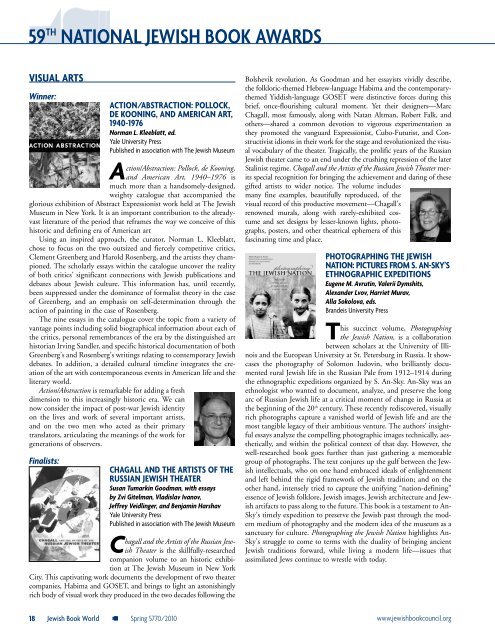reviews - Jewish Book Council
reviews - Jewish Book Council
reviews - Jewish Book Council
Create successful ePaper yourself
Turn your PDF publications into a flip-book with our unique Google optimized e-Paper software.
59 TH NATIONAL JEWISH BOOK AWARDS<br />
VISUAL ARTS<br />
Winner:<br />
ACTION/ABSTRACTION: POLLOCK,<br />
DE KOONING, AND AMERICAN ART,<br />
1940-1976<br />
Norman L. Kleeblatt, ed.<br />
Yale University Press<br />
Published in association with The <strong>Jewish</strong> Museum<br />
Action/Abstraction: Pollock, de Kooning,<br />
and American Art, 1940–1976 is<br />
much more than a handsomely-designed,<br />
weighty catalogue that accompanied the<br />
glorious exhibition of Abstract Expressionist work held at The <strong>Jewish</strong><br />
Museum in New York. It is an important contribution to the alreadyvast<br />
literature of the period that reframes the way we conceive of this<br />
historic and defining era of American art<br />
Using an inspired approach, the curator, Norman L. Kleeblatt,<br />
chose to focus on the two outsized and fiercely competitive critics,<br />
Clement Greenberg and Harold Rosenberg, and the artists they championed.<br />
The scholarly essays within the catalogue uncover the reality<br />
of both critics’ significant connections with <strong>Jewish</strong> publications and<br />
debates about <strong>Jewish</strong> culture. This information has, until recently,<br />
been suppressed under the dominance of formalist theory in the case<br />
of Greenberg, and an emphasis on self-determination through the<br />
action of painting in the case of Rosenberg.<br />
The nine essays in the catalogue cover the topic from a variety of<br />
vantage points including solid biographical information about each of<br />
the critics, personal remembrances of the era by the distinguished art<br />
historian Irving Sandler, and specific historical documentation of both<br />
Greenberg’s and Rosenberg’s writings relating to contemporary <strong>Jewish</strong><br />
debates. In addition, a detailed cultural timeline integrates the creation<br />
of the art with contemporaneous events in American life and the<br />
literary world.<br />
Action/Abstraction is remarkable for adding a fresh<br />
dimension to this increasingly historic era. We can<br />
now consider the impact of post-war <strong>Jewish</strong> identity<br />
on the lives and work of several important artists,<br />
and on the two men who acted as their primary<br />
translators, articulating the meanings of the work for<br />
generations of observers.<br />
Finalists:<br />
CHAGALL AND THE ARTISTS OF THE<br />
RUSSIAN JEWISH THEATER<br />
Susan Tumarkin Goodman, with essays<br />
by Zvi Gitelman, Vladislav Ivanov,<br />
Jeffrey Veidlinger, and Benjamin Harshav<br />
Yale University Press<br />
Published in association with The <strong>Jewish</strong> Museum<br />
Chagall and the Artists of the Russian <strong>Jewish</strong><br />
Theater is the skillfully-researched<br />
companion volume to an historic exhibition<br />
at The <strong>Jewish</strong> Museum in New York<br />
City. This captivating work documents the development of two theater<br />
companies, Habima and GOSET, and brings to light an astonishingly<br />
rich body of visual work they produced in the two decades following the<br />
18 <strong>Jewish</strong> <strong>Book</strong> World Spring 5770/2010<br />
Bolshevik revolution. As Goodman and her essayists vividly describe,<br />
the folkloric-themed Hebrew-language Habima and the contemporarythemed<br />
Yiddish-language GOSET were distinctive forces during this<br />
brief, once-flourishing cultural moment. Yet their designers—Marc<br />
Chagall, most famously, along with Natan Altman, Robert Falk, and<br />
others—shared a common devotion to vigorous experimentation as<br />
they promoted the vanguard Expressionist, Cubo-Futurist, and Constructivist<br />
idioms in their work for the stage and revolutionized the visual<br />
vocabulary of the theater. Tragically, the prolific years of the Russian<br />
<strong>Jewish</strong> theater came to an end under the crushing repression of the later<br />
Stalinist regime. Chagall and the Artists of the Russian <strong>Jewish</strong> Theater merits<br />
special recognition for bringing the achievement and daring of these<br />
gifted artists to wider notice. The volume includes<br />
many fine examples, beautifully reproduced, of the<br />
visual record of this productive movement—Chagall’s<br />
renowned murals, along with rarely-exhibited costume<br />
and set designs by lesser-known lights, photographs,<br />
posters, and other theatrical ephemera of this<br />
fascinating time and place.<br />
PHOTOGRAPHING THE JEWISH<br />
NATION: PICTURES FROM S. AN-SKY’S<br />
ETHNOGRAPHIC EXPEDITIONS<br />
Eugene M. Avrutin, Valerii Dymshits,<br />
Alexander Lvov, Harriet Murav,<br />
Alla Sokolova, eds.<br />
Brandeis University Press<br />
This succinct volume, Photographing<br />
the <strong>Jewish</strong> Nation, is a collaboration<br />
between scholars at the University of Illinois<br />
and the European University at St. Petersburg in Russia. It showcases<br />
the photography of Solomon Iudovin, who brilliantly documented<br />
rural <strong>Jewish</strong> life in the Russian Pale from 1912–1914 during<br />
the ethnographic expeditions organized by S. An-Sky. An-Sky was an<br />
ethnologist who wanted to document, analyze, and preserve the long<br />
arc of Russian <strong>Jewish</strong> life at a critical moment of change in Russia at<br />
the beginning of the 20th century. These recently rediscovered, visually<br />
rich photographs capture a vanished world of <strong>Jewish</strong> life and are the<br />
most tangible legacy of their ambitious venture. The authors’ insightful<br />
essays analyze the compelling photographic images technically, aesthetically,<br />
and within the political context of that day. However, the<br />
well-researched book goes further than just gathering a memorable<br />
group of photographs. The text conjures up the gulf between the <strong>Jewish</strong><br />
intellectuals, who on one hand embraced ideals of enlightenment<br />
and left behind the rigid framework of <strong>Jewish</strong> tradition; and on the<br />
other hand, intensely tried to capture the unifying “nation-defining”<br />
essence of <strong>Jewish</strong> folklore, <strong>Jewish</strong> images, <strong>Jewish</strong> architecture and <strong>Jewish</strong><br />
artifacts to pass along to the future. This book is a testament to An-<br />
Sky’s timely expedition to preserve the <strong>Jewish</strong> past through the modern<br />
medium of photography and the modern idea of the museum as a<br />
sanctuary for culture. Photographing the <strong>Jewish</strong> Nation highlights An-<br />
Sky’s struggle to come to terms with the duality of bringing ancient<br />
<strong>Jewish</strong> traditions forward, while living a modern life—issues that<br />
assimilated Jews continue to wrestle with today.<br />
www.jewishbookcouncil.org


